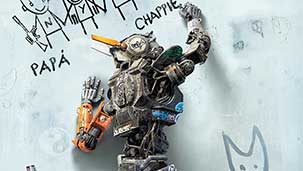When making a big budget, dystopian flick like Neill Blomkamp’s Chappie, your robots truly matter. How they look and whether or not their appearance reflects the mood you are trying to convey is essential to the film’s success or failure. This is especially true if one of the robots is the title character of the aforementioned multi-million dollar extravaganza.
Imagine if the Terminator (once it shed it’s Schwarzenegger) looked liked the robot in a Bugs Bunny cartoon. James Cameron would now be directing the line at McDonalds.
You did a man’s work in helping to develop the visual aesthetic of this particular robot. Chappie is perfectly modulated to allow Sharlto Copley’s motion capture performance to shine through. However, it is a significant problem when a motion capture performance is by far the best part of a film that has a number of actual humans as featured players.
Chappie—the film as opposed to the robot—is a godawful mess, narratively as well as conceptually. The casting ranges from poor (Hugh Jackman, paradoxically both wasted and ill-chosen) to ballsy (Die Antwoord’s Ninja and Yolandi Visser) to curiously misused (Sigourney Weaver and Dev Patel). But they all recede into the background whenever the titular character is on the screen.
Chappie is both derivative and an homage to several films including Short Circuit, Robocop and even makes a more than a cursory nod to Blomkamp’s own District 9. What it doesn’t do, however, is find its own voice. It lurches wildly in tone from gritty to comic to maudlin to occasionally effective.
A lot of that is the script. Too often it relies on what seem to be improvisational moments between Chappie and his adoptive parents—Ninja and Visser—as they try to gangsta Chappie up in order to aid them with their comically ineffective schemes. There is a throwaway plot involving Jackman and his rivalry with Patel. Sigourney Weaver, again wasted in a largely throwaway role, plays a weak echo of her Queen Bitch from Working Girl. At no point in the film do any of these disparate threads cohere in a way that is at all convincing.
The single compelling moment comes early on in the film when Chappie is abandoned to the streets of Johannesburg; it is in this sequence that you see most clearly where Blomkamp can create moments of real human pathos. It is a stark, unrelenting five minutes that stayed with me long after the film ended.
Part of the reason why this sequence succeeds—where most of the film fails—is because it focuses on Chappie’s awakening to the harsh realities of the world he has been born into. It also works because it is uncluttered by any of the cardboard characters that usually fill Blomkamp’s South African landscape.
Copley’s MoCap performance is effective because the robot design evokes a human in form but is still non-specific enough for anyone to identify with—it is the perfect blank slate for the audience to project themselves upon. Chappie also has rudimentary facial expressions that work in ways that are a little surprising, given such a limited palette. He is a creation that deserves, as do you, a far better film.
Perhaps Blomkamp might be better served by adapting other people’s work. Maybe then he could find a way to incorporate the magic you helped him create into a film that compliments that magic—instead of muting it.
Sincerely,

Tim







